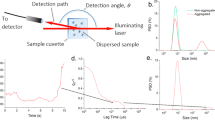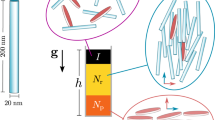Abstract
CENTRIFUGAL sedimentation methods are widely used for determining the particle-size distribution of suspensions of fine solids in liquids. Donoghue and Bostock1 give methods for calculating the cumulative weight size distribution of a sample from the experimental figures. This method is based on filling the centrifuge with the sample under examination, as opposed to the method initially used by Marshall2, and afterwards developed by others3,4, in which the sample is introduced as a thin layer superposed on a clear medium of slightly higher density. This latter method is likely to give inaccurate results with some systems due to the phenomenon of ‘streaming’. Using the former method, the particle size analysis is performed by running the centrifuge for a given time at constant speed and then measuring the amount of sample which has either sedimented to (or past) a certain radius in the centrifuge, or which remains above this radius. It is immaterial for the purpose of this note which method of measurement is used. The complete size distribution is determined by one of three methods: (1) The inner radius of the liquid surface and the outer radius of collection are kept constant and samples are collected after varying running times of the centrifuge. (We assume the centrifuge speed is kept constant for all experiments.) (2) The running time of the centrifuge is kept constant, as is the inner radius of the liquid, and the outer collection radius is varied. (3) The running time of the centrifuge is kept constant as before, but the outer collection radius is kept constant for successive measurements, while the inner liquid surface radius is varied.
This is a preview of subscription content, access via your institution
Access options
Subscribe to this journal
Receive 51 print issues and online access
$199.00 per year
only $3.90 per issue
Buy this article
- Purchase on Springer Link
- Instant access to full article PDF
Prices may be subject to local taxes which are calculated during checkout
Similar content being viewed by others
References
Donoghue, J. K., and Bostock, W., Trans. Inst. Chem. Eng., 33, 72 (1955).
Marshall, C. E., J. Soc. Chem. Indust., 50, 444T (1931).
Disk centrifuge manufactured by Joyce-Loebl and Co. Ltd., Gateshead, under licence from I.C.I. Ltd., Dyestuffs Division, Blackley.
Kaye, B. H., Brit. Patent No. 895, 222 (1962), also The Analyst, 88, 173 (March, 1963).
Author information
Authors and Affiliations
Rights and permissions
About this article
Cite this article
MURLEY, R. An Improved Method of calculating Particle Size Distribution from Centrifugal Sedimentation Experiments. Nature 207, 1089–1090 (1965). https://doi.org/10.1038/2071089a0
Published:
Issue Date:
DOI: https://doi.org/10.1038/2071089a0
Comments
By submitting a comment you agree to abide by our Terms and Community Guidelines. If you find something abusive or that does not comply with our terms or guidelines please flag it as inappropriate.



